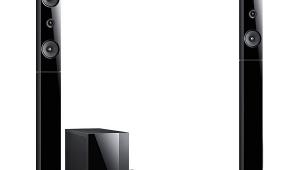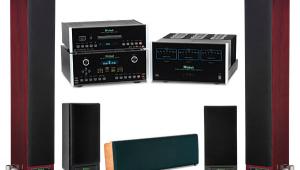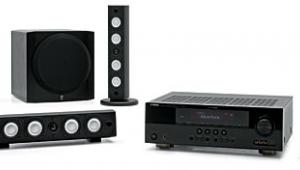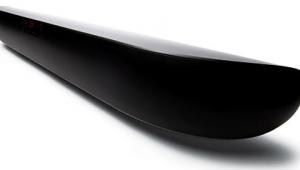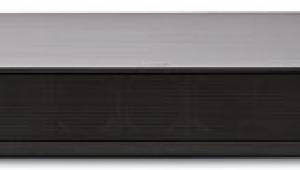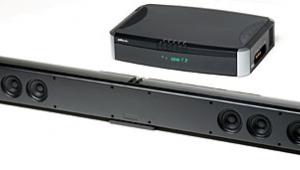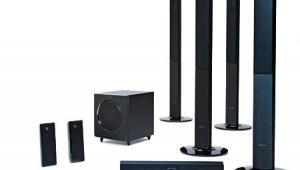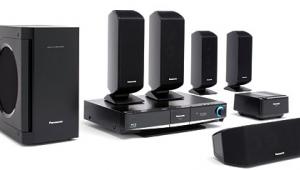Sony DAV-LF1 DVD Platinum Dream System
If not for all the wires, Sony's wireless DAV-LF1 DVD Platinum Dream System would be absolutely dreamy. Even with today's technology, a home theater can't do wireless like a cell phone or a home network or laptop stoked with Wi-Fi. The best it can do is wireless surround speakers—that is, no wires between the surround speakers and the A/V receiver. But, as with the DAV-LF1, these speakers are routinely wired to each other and require a nearby electrical outlet for a wireless receiver. If this were the meat department, home of the semi-boneless ham, we'd call it semi-wireless.

The wireless DAV-LF1 thus becomes an oxymoronic home theater concept that not only requires wires but sometimes demands more wires than a conventional wired home theater. Yet the beauty of the DAV-LF1, aside from its inspired svelte-and-silver design, is the absence of those nasty wires snaking across the room to the surround speakers.
For wire-haters who have a flat-panel television mounted on a wall, the DAV-LF1 adds the further enticement of an extraordinarily flat, equally wall-mountable system that complements a plasma or LCD in an almost eerie, genetic-engineering way. Even with a non-Sony flat panel, such as the Philips 42PF9996 42-inch LCD in my home for a brief visit, the DAV-LF1 looked like a DNA-matched system.
Sony did technological handstands to pull it off: The freestanding control unit, for instance, is fed by electronics stashed in the base of the subwoofer, the center speaker processes commands from the remote control, and the wireless infrared receiver is built into one of the surround speakers' grilles.
Unless you have a wall-mounted flat-panel TV and plan to mount part of the DAV-LF1 alongside it, however, this home theater system quickly loses some appeal. Comparable performance, both audio and video, is available in some home-theater-in-a-box systems costing half the DAV-LF1's $2,000 retail price. No matter how you cut it, the wireless speakers simply do not sound as good as wired speakers. With the DAV-LF1, you're paying for looks, style, and the ability to preserve a floor plan that needn't apologize for wires stretching across the room.
The Floating-Glass Theory
The DAV-LF1, the first system in the Platinum DVD Dream Series, was inspired by Sony's floating-glass flat-panel Wega plasma televisions. You'll see the resemblance in the glazed metallic-frost finish (that's silver in simpler terms) behind the floating-glass faceplate design of the DAV-LF1's DVD/SACD control unit. It's not exactly metal (it's plastic), and it's not exactly glass (it's acrylic), but from a distance who's going to know?
You'll have plenty of time to gaze into this wall of silver as it loads an SACD (20 seconds), DVD (15 seconds), or CD (10 seconds). It's pretty, all right, but no one said it was fast. A pushbutton adjoining the rear-mounted disc transport shines red when the control unit is in standby mode. When powered on, a tiny white light shines through the plastic on the faceplate. Four more lights on the far right indicate the surround modes, and a 2.25-inch square, mirrored display doubles as a too-cool touchscreen for transport controls and source selection. However, if you put the control unit on the wall where it belongs, you might not mess much with the touchscreen. You'll get very friendly with the full-sized remote control and its undersized buttons.
The four satellite speakers look like a brushed-aluminum cricket bat—think of the demure sport played in all white—with a gray, fine-mesh grille on a stick of a silver stand. Unscrew them from the metal/plastic stands, however, and they're a picture-perfect candidate for hanging on the wall: 27.5 inches high, 6 wide, and only 2 deep. The subwoofer could have been pulled from a compactor seconds before it became a single, solid mass. Instead, it's a two-story, connected-at-the-hip component with two drivers residing in the dull-silver upstairs compartment and the electronics—the Dolby Digital, DTS, and SACD processing, along with digital amplification and connections—wedged into a glistening, mirrored-finish base.
The two pieces connect at a four-sided plastic vent for the subwoofer. Look up into the vent, and you'll see a 7.18-inch paper cone driver firing downward. There's another front-firing driver aligned in a push-pull configuration in the upper reaches of the tower. That driver vents through a small port on the backside. The drivers are powered by independent 85-watt amplifiers.
Purists cringe at subwoofers firing directly at a system's electronics, which can be vulnerable to vibration, but it's one of the trade-offs Sony made to turn the DAV-LF1 into a flashy lifestyle system. If the DVD/SACD control unit included these additional electronics, it would be too cumbersome to hang on the wall. Instead, the splendid silver splinter connects to the amplifier with a proprietary white umbilical cord, as thick as a power cable.
Because it doubles as the amp/processor, the subwoofer can't stray too far from the television. Remember, your TV will be connected to the sub via component video cables (the DAV-LF1 offers neither DVI nor HDMI digital connections). If you use headphones, you'll need to plug them into the back of the sub, too.
Like the subwoofer, the center speaker also performs double duty. The 2.25-inch plastic square on the mesh grille conceals an IR receiver for the DAV-LF1's remote control. Whereas the two front speakers attach to the amp with snap-in connectors, the center-speaker cable is joined by a third wire within a white umbilical cord terminated by a mini-jack that delivers the remote commands to the amp/processor.
A transmitter the size of a clamshell cell phone, tethered by wire to another mini-jack on the amplifier, sends audio signals from the amplifier up to 33 feet to the surround speaker equipped with the IR receiver. That speaker must be plugged into an AC outlet and also connected by speaker wire to the other surround speaker. A green light on the IR receiver embedded in the speaker grille indicates that the signal has made its way to the speaker (a red light means no signal). The other surround speaker has a matching 2.25-inch square plastic panel on the grille, but it's for cosmetics only.
